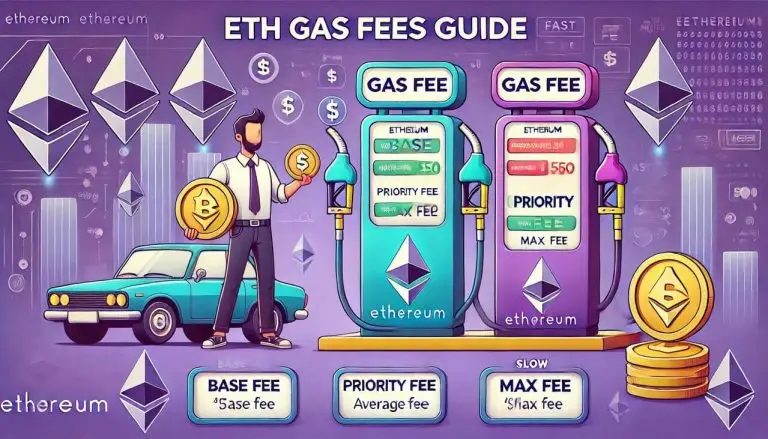Ethereum remains a leading blockchain for decentralized applications, NFTs, and crypto transactions. However, understanding ETH gas fees is crucial for efficient trading and minimizing costs. In this 2025 guide, we’ll explore what gas fees are, how they work, and practical strategies to save money while navigating the Ethereum network.
Key Insights:
- ETH gas fees are transaction costs paid to validators for processing actions on the Ethereum blockchain, measured in Gwei. Fees vary based on network congestion, transaction complexity, and user priority.
- Save on gas fees by transacting during off-peak hours, using Layer 2 solutions like Arbitrum and Optimism, adjusting gas settings in wallets like MetaMask, and batching multiple transactions into one.
- Ethereum’s transition to Proof-of-Stake has improved efficiency, reduced energy consumption by 99.9%, and made gas fees more predictable, although demand still influences costs.
- Platforms like Coinrule, MetaMask, and Etherscan Gas Tracker help users monitor and optimize gas fees, ensuring cost-effective transactions in the Ethereum ecosystem.
What Are ETH Gas Fees?
ETH gas fees are transaction costs paid to Ethereum network validators for processing and securing transactions. Every action on the Ethereum blockchain—whether transferring ETH, minting NFTs, or using DeFi protocols—requires computational power. Gas fees compensate miners (now validators under Ethereum 2.0’s Proof-of-Stake system) for their work.
Key Points About ETH Gas Fees:
- Measured in Gwei: Gas fees are calculated in Gwei, a small fraction of ETH. 1 ETH = 1 billion Gwei.
- Variable Costs: Fees depend on network activity, transaction complexity, and user priority.
- Two Components: The base fee (set by the network) and the priority fee (optional tip for faster processing).
How ETH Gas Fees Work in 2025
Ethereum’s EIP-1559 upgrade introduced a more predictable fee structure by splitting the gas fee into:
- Base Fee: The minimum fee required for a transaction, adjusted according to network congestion.
- Priority Fee (Tip): An extra incentive for validators to prioritize your transaction.
- Max Fee: The maximum amount you’re willing to pay, ensuring cost control.
Additionally, under Ethereum 2.0’s Proof-of-Stake system, gas fees are less volatile, though network demand still plays a significant role.
Why Do ETH Gas Fees Fluctuate?
ETH gas fees fluctuate based on three primary factors:
- Network Congestion: During peak times, like major NFT drops or token launches, fees rise due to high demand for block space.
- Transaction Complexity: Simple ETH transfers cost less than complex smart contract interactions.
- User Priority: If you want faster transaction confirmation, you’ll pay a higher priority fee.
How to Check ETH Gas Fees in Real-Time
To avoid overpaying, always check current gas prices before initiating transactions. Reliable platforms include:
- Etherscan Gas Tracker: Provides real-time gas fees for low, average, and high-priority transactions.
- GasNow: Offers quick insights into current gas prices and estimated transaction costs.
- Crypto Wallets: Many wallets, like MetaMask, display gas fees before you confirm a transaction.
How to Reduce ETH Gas Fees in 2025
Managing gas fees effectively can save you significant money. Here are some practical tips:
- Transact During Off-Peak Hours: Gas fees are lower during weekends, late nights (UTC), or early mornings when network demand is lower.
- Use Layer 2 Solutions: Platforms like Arbitrum, Optimism, and zkSync offer faster and cheaper transactions without compromising security.
- Adjust Gas Settings: In wallets like MetaMask, set a custom Max Fee and Priority Fee based on current network conditions.
- Batch Transactions: If possible, combine multiple transactions into one to save on fees.
- Monitor Gas Prices: Use gas tracking tools to time your trades effectively.
ETH Gas Fees for Popular Transactions (2025 Estimates)
Here’s a rough breakdown of gas fees for common Ethereum activities:
| Transaction Type | Low Priority (Gwei) | Average Priority (Gwei) | High Priority (Gwei) | Estimated USD Cost |
| ETH Transfer | 10 | 20 | 40 | $1 – $3 |
| ERC-20 Token Swap | 20 | 40 | 80 | $3 – $10 |
| NFT Minting | 50 | 100 | 150 | $10 – $30 |
| DeFi Transaction | 30 | 60 | 120 | $5 – $20 |
Note: Costs vary based on ETH price and network congestion.
ETH Gas Fees and Ethereum 2.0: What’s Changed?
Ethereum’s transition to Proof-of-Stake (PoS) significantly improved network efficiency, but gas fees still depend on demand. While base fees are now burned (reducing ETH supply and potentially boosting ETH’s value), users still compete for block space, keeping fees dynamic.
Key improvements under Ethereum 2.0 include:
- Lower Volatility: Gas fees are more predictable.
- Environmental Efficiency: PoS consumes 99.9% less energy.
- Layer 2 Integration: Faster, cheaper transactions via rollups and sidechains.
Best Tools for Managing ETH Gas Fees
To navigate ETH gas fees efficiently, consider using these platforms:
- Coinrule: Automate crypto trades and optimize transaction timing based on real-time gas prices.
- MetaMask: Set custom gas fees and monitor costs before confirming transactions.
- Etherscan Gas Tracker: Real-time fee insights and transaction estimations.
- DeBank: Track gas usage across wallets and platforms.
Conclusion: Mastering ETH Gas Fees in 2025
Understanding and managing ETH gas fees is essential for cost-effective Ethereum transactions. By monitoring gas prices, using Layer 2 solutions, and automating trades with platforms like Coinrule, you can navigate the Ethereum ecosystem more efficiently.
Whether you’re trading, minting NFTs, or interacting with DeFi protocols, a strategic approach to gas fees will help you save money and trade smarter.
Follow Our Official Social Channels:
